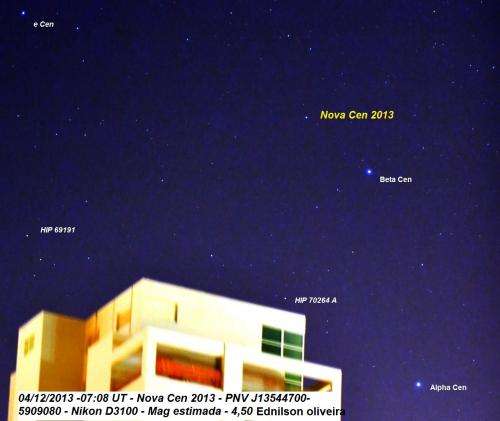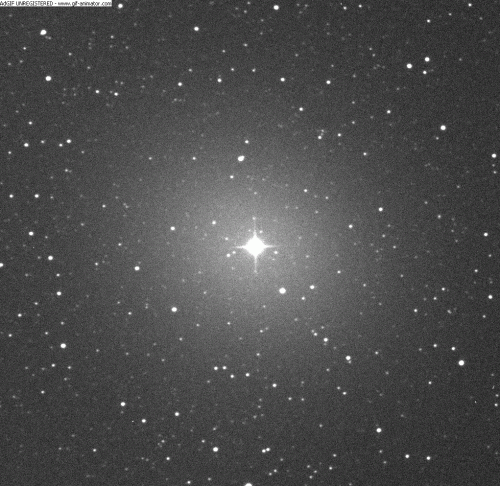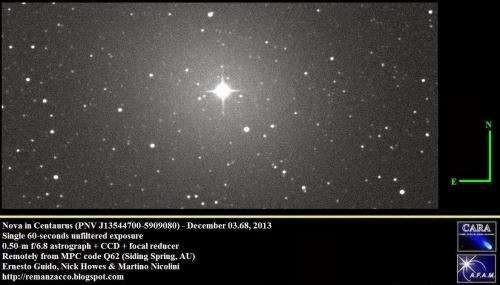A naked eye nova erupts in Centaurus

If you live in the southern hemisphere, the southern sky constellation of Centaurus may look a little different to you tonight, as a bright nova has been identified in the region early this week.
The initial discovery of Nova Centauri 2013 (Nova Cen 2013) was made by observer John Seach based out of Chatsworth Island in New South Wales Australia. The preliminary discovery magnitude for Nova Cen 2013 was magnitude +5.5, just above naked eye visibility from a good dark sky site. Estimates by observers over the past 24 hours place Nova Cen 2013 between magnitudes +4 and +5 "with a bullet," meaning this one may get brighter still as the week progresses.
We first got wind of the discovery via the American Association of Variable Star Observers yesterday afternoon when alert notice 492 was issued. Established in 1911, the AAVSO is a great resource for info and a fine example of amateur collaboration in the effort to conduct real scientific observation.
Follow-up spectra measurements by Rob Kaufman in White Cliffs Australia and Malcolm Locke in Christchurch New Zealand demonstrated the presence of strong hydrogen alpha and hydrogen beta emission lines, the classic hallmark of an erupting nova. Like Nova Delphini 2013 witnessed by observers in the northern hemisphere, this is a garden variety nova located in our own galaxy, going off as seen along the galactic plane from our Earthbound perspective. A handful of galactic novae are seen each year, but such a stellar conflagration reaching naked eye visibility is worthy of note. In fact, Nova Cen 2013 is already knocking on the ranks of the 30 brightest novae observed of all time.
This is not to be confused with a supernova, the last of which observed in our galaxy was Kepler's Supernova in 1604, just before the advent of the telescope in modern astronomy. Supernovae are seen in other galaxies all the time, but here at home, you could say we're "due".
So, who can see Nova Cen 2013, and who's left out? Well, the coordinates for the nova are:
Right Ascension: 13 Hours 54' 45"
Declination: -59°S 09' 04"

That puts it deep in the southern celestial hemisphere sky where the constellation Centaurus meets up with the constellations of Circinus, Musca and the Crux. Located within three degrees of the +0.6th magnitude star Hadar—also named Beta Centauri—it would be possible to capture the southern deep sky objects of the Coal Sack and Omega Centauri with Nova Cen 2013 in the same wide field of view.
Though Nova Cen 2013 technically peeks above the southern horizon from the extreme southern United States, the viewing circumstances aren't great. In fact, the nova only rises just before the Sun as seen from Miami in December, at 25 degrees north latitude. The Centaurus region is much better placed in northern hemisphere during the springtime, when many southern tier states can actually glimpse the celestial jewels that lie south, such as Omega Centauri.
But the situation gets better, the farther south you go. From Guayaquil, Ecuador just below the equator, the nova rises to the southeast at about 3 AM local, and sits 20 degrees above the horizon at sunrise.

The nova will be circumpolar for observers south of -30 degrees latitude, including cities of Buenos Aires, Cape Town, Sydney and Auckland. Remember, its springtime currently in the southern hemisphere, as we head towards the solstice on December 21st and the start of southern hemisphere summer. We've been south of the equator about a half dozen times and it's a unique experience – for northern star gazers, at least – to see familiar northern constellations such as Orion and Leo hang "upside down" as strange a wonderful new constellations beckon the eye to the south. Also, though the Sun still rises to the east, it transits to the north as you get deep into the southern hemisphere, a fun effect to note!
Latitudes, such as those on par with New Zealand, will get the best views of Nova Cen 2013. Based near latitude 40 degrees south, observers will see the nova about 10 degrees above the southern horizon at lower culmination at a few hour after sunset, headed towards 40 degrees above the southeastern horizon at sunrise.
All indications are that Nova Cen 2013 is a classical nova, a white dwarf star accreting matter from a binary companion until a new round of nuclear fusion occurs. Recurrent novae such as T Pyxidis or U Scorpii may erupt erratically in this fashion over the span of decades.
As of yet, there is no firm distance measurement for Nova Cen 2013, though radio observations with southern sky assets may pin it down. One northern hemisphere based program, known as the EVLA Nova Project, seeks to do just that.
Congrats to John Seach on his discovery, and if you find yourself under southern skies, be sure to check out this astrophysical wonder!
Source: Universe Today


















